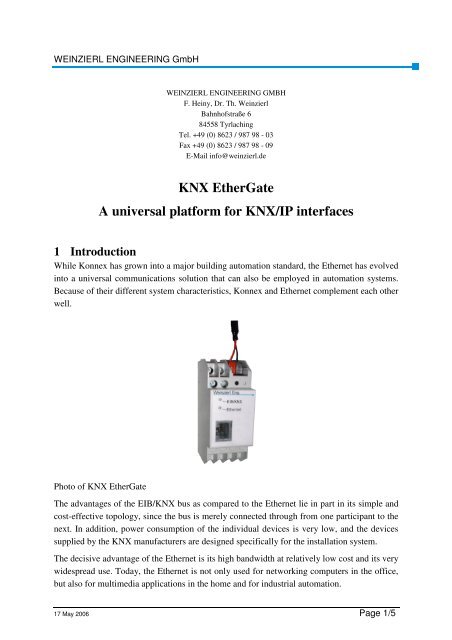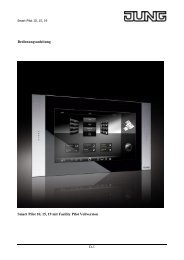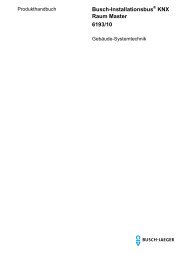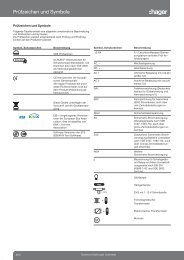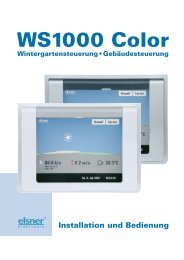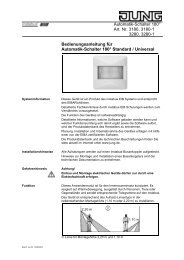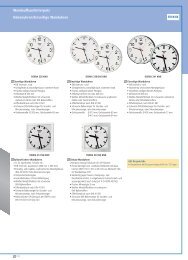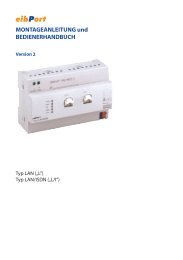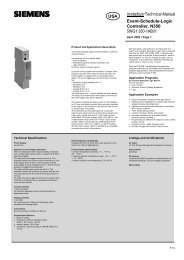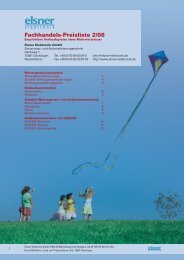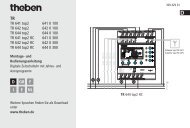KNX EtherGate A universal platform for KNX/IP interfaces
KNX EtherGate A universal platform for KNX/IP interfaces
KNX EtherGate A universal platform for KNX/IP interfaces
You also want an ePaper? Increase the reach of your titles
YUMPU automatically turns print PDFs into web optimized ePapers that Google loves.
WEINZIERL ENGINEERING GmbH<br />
WEINZIERL ENGINEERING GMBH<br />
F. Heiny, Dr. Th. Weinzierl<br />
Bahnhofstraße 6<br />
84558 Tyrlaching<br />
Tel. +49 (0) 8623 / 987 98 - 03<br />
Fax +49 (0) 8623 / 987 98 - 09<br />
E-Mail info@weinzierl.de<br />
<strong>KNX</strong> <strong>EtherGate</strong><br />
A <strong>universal</strong> <strong>plat<strong>for</strong>m</strong> <strong>for</strong> <strong>KNX</strong>/<strong>IP</strong> <strong>interfaces</strong><br />
1 Introduction<br />
While Konnex has grown into a major building automation standard, the Ethernet has evolved<br />
into a <strong>universal</strong> communications solution that can also be employed in automation systems.<br />
Because of their different system characteristics, Konnex and Ethernet complement each other<br />
well.<br />
Photo of <strong>KNX</strong> <strong>EtherGate</strong><br />
The advantages of the EIB/<strong>KNX</strong> bus as compared to the Ethernet lie in part in its simple and<br />
cost-effective topology, since the bus is merely connected through from one participant to the<br />
next. In addition, power consumption of the individual devices is very low, and the devices<br />
supplied by the <strong>KNX</strong> manufacturers are designed specifically <strong>for</strong> the installation system.<br />
The decisive advantage of the Ethernet is its high bandwidth at relatively low cost and its very<br />
widespread use. Today, the Ethernet is not only used <strong>for</strong> networking computers in the office,<br />
but also <strong>for</strong> multimedia applications in the home and <strong>for</strong> industrial automation.<br />
17 May 2006 Page 1/5
WEINZIERL ENGINEERING GmbH<br />
Despite, and indeed because of, the high transmission speeds, LAN networks cannot replace<br />
the <strong>KNX</strong> bus. Instead, the combination of Konnex TP1 and LAN provides an optimal solution<br />
<strong>for</strong> future building automation. Konnex TP1 is primarily suited <strong>for</strong> local control, while the<br />
LAN is used <strong>for</strong> inter-system communication. The transmission of control commands can<br />
take place in a LAN network together with Internet use, PC networking and multimedia.<br />
Overall, this results in a hierarchical architecture <strong>for</strong> building networking.<br />
2 Routing in hierarchical architectures<br />
One major motivation to extend the Konnex system with the Ethernet is to increase the<br />
transmission capacity of the overall system. Although the transmission speed of 9600 bit/s is<br />
fully adequate to <strong>for</strong>m a bus line with up to 256 participants, a higher bandwidth may be<br />
needed in the backbone if a system has numerous lines that are connected by a line coupler.<br />
This is especially critical if the system contains devices used <strong>for</strong> purposes such as<br />
visualization to which all telegrams need to be transmitted. In this case, there can be no<br />
selective routing.<br />
LAN<br />
Client<br />
(ETS)<br />
EIB/<strong>KNX</strong><br />
Application of the <strong>KNX</strong>net/<strong>IP</strong> Routing standard<br />
LAN<br />
Switch<br />
EIB/<strong>KNX</strong><br />
<strong>KNX</strong>-<strong>IP</strong><br />
Tunneling & Routing<br />
Here, the high bandwidth of a LAN network offers an optimal solution. While with Konnex<br />
TP1 a maximum of only 50 telegrams can be transmitted per second, transmission via LAN<br />
exceeds 10,000 telegrams at 10 MBit/s.<br />
Since the Ethernet is of great significance to the installation system as the backbone, it was<br />
standardized in Konnex. The Routing subtopic of the <strong>KNX</strong>net/<strong>IP</strong> specification (<strong>for</strong>merly<br />
EIBnet/<strong>IP</strong>) describes how <strong>KNX</strong>/<strong>IP</strong> gateways <strong>for</strong>ward telegrams via <strong>IP</strong>. For <strong>for</strong>warding via the<br />
Ethernet, the <strong>KNX</strong> telegrams are individually packed in UDP/<strong>IP</strong> telegrams and sent via the<br />
Ethernet as multicast telegrams. All <strong>KNX</strong>/<strong>IP</strong> routers in the network can receive these<br />
telegrams simultaneously and use their routing tables to determine whether to <strong>for</strong>ward the<br />
telegram into the connected <strong>KNX</strong> line.<br />
17 May 2006 Page 2/5
WEINZIERL ENGINEERING GmbH<br />
3 Tunnelling: PC access via a LAN connection<br />
While routing is used <strong>for</strong> runtime communication, tunnelling refers to access, such as from a<br />
PC to a <strong>KNX</strong> network, during configuration and start-up. The connection of a client (PC) with<br />
a bus line or with an individual <strong>KNX</strong> device is of central importance. The tunnelling<br />
procedure is defined in the <strong>KNX</strong>net/<strong>IP</strong> as well and also uses UDP. <strong>KNX</strong>/<strong>IP</strong> devices that<br />
support tunnelling can, <strong>for</strong> example, replace RS232 <strong>interfaces</strong> that in the past were used <strong>for</strong><br />
bus access.<br />
Application of the <strong>KNX</strong>net/<strong>IP</strong> Tunnelling standard<br />
Client<br />
EIB/<strong>KNX</strong><br />
<strong>KNX</strong>-<strong>IP</strong><br />
4 Object server: From the telegram to the data point<br />
For an increasing number of devices, such as in the areas of multimedia and security<br />
technology, the exchange of control in<strong>for</strong>mation with the building automation is of<br />
significance. However, <strong>for</strong> certain devices it is preferable to not access the bus directly.<br />
Instead, a connection can be established to the <strong>KNX</strong> via the Ethernet. Communication via the<br />
Ethernet is particularly interesting <strong>for</strong> devices that are already equipped with a network port.<br />
If the protocol stack <strong>for</strong> TCP/UDP/<strong>IP</strong> already exists in the operating system, applications can<br />
communicate with other devices via the Ethernet with little additional ef<strong>for</strong>t. This applies to<br />
many Linux-based devices.<br />
If you were to use tunnelling or routing as a solution, the devices would be able to access the<br />
<strong>KNX</strong> network but would still have to generate and interpret <strong>KNX</strong> telegrams.<br />
It is far simpler <strong>for</strong> the <strong>KNX</strong>/<strong>IP</strong> interface to take over this task. In this case, the <strong>KNX</strong>/<strong>IP</strong><br />
gateway assumes the roll of a <strong>KNX</strong> terminal. This means that the <strong>KNX</strong> communication<br />
software also contains the data points, making it possible <strong>for</strong> the device to interpret received<br />
telegrams.<br />
A client can access the data points via TCP/<strong>IP</strong> without having to know the syntax of the <strong>KNX</strong><br />
telegrams. The data points are configured using the ETS software (Engineering Tool<br />
Software). The group addresses are downloaded to the <strong>KNX</strong>/<strong>IP</strong> gateway. To the <strong>KNX</strong> bus and<br />
the ETS, the combination of the terminal and the <strong>KNX</strong>/<strong>IP</strong> device thus has the appearance of a<br />
standard bus participant.<br />
17 May 2006 Page 3/5<br />
LAN
WEINZIERL ENGINEERING GmbH<br />
5 Hardware<br />
The hardware is an ideal <strong>plat<strong>for</strong>m</strong> <strong>for</strong> various gateways between <strong>KNX</strong> and <strong>IP</strong>. At its core is a<br />
microcontroller that is connected to the LAN via a network chip and that can communicate<br />
with the <strong>KNX</strong> via a TP-UART. It has sufficient computing power and memory capacity to<br />
implement various applications in parallel.<br />
The <strong>KNX</strong>/<strong>IP</strong> gateway hardware<br />
Power can be drawn from an external power source of 12-24 V. In addition, the gateway<br />
supports the Power over Ethernet Standard (PoE). If the device is operated with a switch that<br />
also supports PoE, an external supply is not necessary. The device is connected to the switch<br />
merely by means of a patch cable (RJ45) and connected to the bus via a bus terminal. Its<br />
power consumption is approx. 800 mW. The Ethernet and <strong>KNX</strong> connections are electrically<br />
isolated.<br />
6 Software<br />
The core of the software is a lean operating system that was optimised <strong>for</strong> the <strong>KNX</strong>/<strong>IP</strong><br />
gateway hardware. It contains a <strong>KNX</strong> stack and the stack <strong>for</strong> the TCP/UDP/<strong>IP</strong>. Applications<br />
can use the various protocols listed below.<br />
The software architecture<br />
EIBnet/<strong>IP</strong><br />
<strong>IP</strong>/UDP<br />
Ethernet<br />
<strong>KNX</strong> Common Kernel<br />
<strong>KNX</strong>-Frames<br />
Message<br />
KnxLl<br />
Link Layer<br />
17 May 2006 Page 4/5
WEINZIERL ENGINEERING GmbH<br />
The following protocols are available:<br />
• <strong>IP</strong> with ARP, DHCP<br />
• UDP <strong>for</strong> <strong>KNX</strong>net/<strong>IP</strong><br />
• TCP <strong>for</strong> Objekt Server or Web Server<br />
• <strong>KNX</strong>net/<strong>IP</strong> Core Services<br />
• <strong>KNX</strong>net/<strong>IP</strong> Tunnelling<br />
• <strong>KNX</strong>net/<strong>IP</strong> Routing<br />
• <strong>KNX</strong> Object Server<br />
• HTTP (Web Server)<br />
• <strong>KNX</strong> Stack (Common Kernel)<br />
Literature<br />
[1] Konnex Association: <strong>KNX</strong> Standard (Version 1.1), Brussels, February 2004; CD-ROM<br />
[2] Weinzierl, Thomas: A new development kit <strong>for</strong> EIB/<strong>KNX</strong> devices based on TP-UART<br />
chip; Proceedings <strong>KNX</strong> Scientific Conference 2002, TU-München October 2002<br />
[3] F. Heiny, Dr. Y. Kyselytsya, Dr. Th. Weinzierl: Virtual <strong>KNX</strong>/EIB devices in <strong>IP</strong><br />
networks; Tagungsband Konnex Scientific Conference 2004, FH Deggendorf 5.10.2004<br />
[4] Weinzierl, Thomas: EIB-USB Data Interface; Proceedings EIB Scientific Conference<br />
2001, TU-München October 2001<br />
[5] Weinzierl, Thomas: Integriertes Managementkonzept für die Gebäudesystemtechnik;<br />
Pflaum Verlag München 2001; ISBN 3-7905-0851-9<br />
[6] Weinzierl, Thomas: <strong>KNX</strong>-RF Ein neuer Standard für drahtlose Netzwerke in Gebäuden;<br />
Tagungsband Entwickler<strong>for</strong>um “ZigBee & Co – Drahtlose Nahbereichsnetze”, Design<br />
& Elektronik; München, 20. April 2005;<br />
[7] More in<strong>for</strong>mation available at www.weinzierl.de<br />
17 May 2006 Page 5/5


